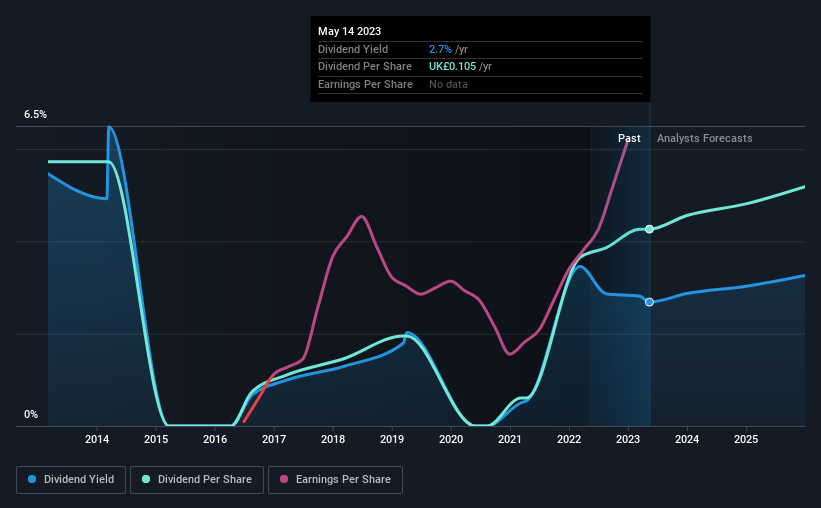Why You Might Be Interested In Balfour Beatty plc (LON:BBY) For Its Upcoming Dividend
Readers hoping to buy Balfour Beatty plc (LON:BBY) for its dividend will need to make their move shortly, as the stock is about to trade ex-dividend. The ex-dividend date occurs one day before the record date which is the day on which shareholders need to be on the company's books in order to receive a dividend. The ex-dividend date is important as the process of settlement involves two full business days. So if you miss that date, you would not show up on the company's books on the record date. Meaning, you will need to purchase Balfour Beatty's shares before the 18th of May to receive the dividend, which will be paid on the 5th of July.
The company's next dividend payment will be UK£0.07 per share, and in the last 12 months, the company paid a total of UK£0.10 per share. Calculating the last year's worth of payments shows that Balfour Beatty has a trailing yield of 2.7% on the current share price of £3.912. If you buy this business for its dividend, you should have an idea of whether Balfour Beatty's dividend is reliable and sustainable. So we need to investigate whether Balfour Beatty can afford its dividend, and if the dividend could grow.
View our latest analysis for Balfour Beatty
If a company pays out more in dividends than it earned, then the dividend might become unsustainable - hardly an ideal situation. Balfour Beatty has a low and conservative payout ratio of just 22% of its income after tax. Yet cash flow is typically more important than profit for assessing dividend sustainability, so we should always check if the company generated enough cash to afford its dividend. Fortunately, it paid out only 43% of its free cash flow in the past year.
It's positive to see that Balfour Beatty's dividend is covered by both profits and cash flow, since this is generally a sign that the dividend is sustainable, and a lower payout ratio usually suggests a greater margin of safety before the dividend gets cut.
Click here to see the company's payout ratio, plus analyst estimates of its future dividends.
Have Earnings And Dividends Been Growing?
Stocks in companies that generate sustainable earnings growth often make the best dividend prospects, as it is easier to lift the dividend when earnings are rising. If earnings fall far enough, the company could be forced to cut its dividend. For this reason, we're glad to see Balfour Beatty's earnings per share have risen 16% per annum over the last five years. Earnings per share have been growing rapidly and the company is retaining a majority of its earnings within the business. Fast-growing businesses that are reinvesting heavily are enticing from a dividend perspective, especially since they can often increase the payout ratio later.
The main way most investors will assess a company's dividend prospects is by checking the historical rate of dividend growth. Balfour Beatty's dividend payments per share have declined at 2.9% per year on average over the past 10 years, which is uninspiring. It's unusual to see earnings per share increasing at the same time as dividends per share have been in decline. We'd hope it's because the company is reinvesting heavily in its business, but it could also suggest business is lumpy.
To Sum It Up
Is Balfour Beatty worth buying for its dividend? It's great that Balfour Beatty is growing earnings per share while simultaneously paying out a low percentage of both its earnings and cash flow. It's disappointing to see the dividend has been cut at least once in the past, but as things stand now, the low payout ratio suggests a conservative approach to dividends, which we like. Balfour Beatty looks solid on this analysis overall, and we'd definitely consider investigating it more closely.
On that note, you'll want to research what risks Balfour Beatty is facing. We've identified 4 warning signs with Balfour Beatty (at least 1 which can't be ignored), and understanding these should be part of your investment process.
Generally, we wouldn't recommend just buying the first dividend stock you see. Here's a curated list of interesting stocks that are strong dividend payers.
Have feedback on this article? Concerned about the content? Get in touch with us directly. Alternatively, email editorial-team (at) simplywallst.com.
This article by Simply Wall St is general in nature. We provide commentary based on historical data and analyst forecasts only using an unbiased methodology and our articles are not intended to be financial advice. It does not constitute a recommendation to buy or sell any stock, and does not take account of your objectives, or your financial situation. We aim to bring you long-term focused analysis driven by fundamental data. Note that our analysis may not factor in the latest price-sensitive company announcements or qualitative material. Simply Wall St has no position in any stocks mentioned.
Join A Paid User Research Session
You’ll receive a US$30 Amazon Gift card for 1 hour of your time while helping us build better investing tools for the individual investors like yourself. Sign up here

 Yahoo Finance
Yahoo Finance 
